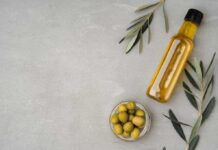If you are living with pain, adding herbs to your regimen may help to ease your discomfort, especially when combined with regular exercise, diet, and relaxation techniques.

At the root of many pain-causing conditions such as arthritis, back pain, and tendonitis is inflammation. Long-term inflammation puts you at risk factor for chronic diseases like cancer, cardiovascular disease, and diabetes.1
This article looks at six herbs that are often used for natural pain relief. It explains scientific research related to specific health claims and warnings about when you should avoid using herbal treatments.
White Willow Bark
Containing an aspirin-like compound known as salicin, white willow bark has been used for centuries as a natural remedy for inflammation and pain. Research has shown that taking willow bark may be as effective as taking conventional anti-inflammatory medications for the relief of knee pain and musculoskeletal pain.2
In addition to salicin, willow bark contains plant chemicals called polyphenols and flavonoids. Researchers think that the combination of material in willow bark make it effective at treating headache, easing muscle pain, and calming inflammation.3
It doesn’t seem to help with fever, though.
White willow bark may also alleviate acute back pain, joint pain, and osteoarthritis. However, like aspirin, the bark may cause stomach upset, affect kidney function, prolong bleeding time, and increase the risk of bleeding. Also, it shouldn’t be used by children.4
Boswellia
Boswellia comes from a resin found in the bark of the frankincense tree. Bosellia oil is used in the manufacturing of food, cosmetics, soaps, and drinks. When used medicinally for pain, though, is often taken by mouth as a pill.
Practitioners of Ayurveda, a healing practice from India, have long used Bosellia to relieve joint and muscle pain. Modern scientists have found that there’s reason to trust that practice. Studies show that Boswellia can reduce pain and improve mobility in those with osteoarthritis.5
Also, a cream made from Boswellia oil has been shown to help ease painful skin damage caused by cancer radiation treatment.
Devil’s Claw
Traditionally used for rheumatoid arthritis, the South African herb devil’s claw may also soothe pain resulting from osteoarthritis, tendonitis, and back and neck troubles, according to proponents.
Studies have shown that devil’s claw contains powerful pain-relieving and anti-inflammatory properties.6 It’s been shown to improve symptoms of arthritis and pain. People report that taking it has improved their quality of life and ability to live with certain conditions.
Bromelain
Bromelain reduces levels of hormones in the body that control inflammation. These hormones are known as prostaglandins, they initiate inflammation and keep it going.
There is research showing brome can benefit people with arthritis and conditions associated with musculoskeletal tension such as temporomandibular joint (TMJ) syndrome. TMJ causes pain around the jaw and surrounding areas including the ears and eyes. Bromelain may also help those suffering from inflammation related to an accident or physical trauma. It may promote healing in muscles and connective tissues.
Bromelain is extracted from the stems of pineapples. While the meat of the pineapple does contain a small amount of bromelain, it isn’t enough to be medicinally helpful. Usually, it’s offered as a pill or tablet to people with inflammation or infection.
Turmeric
Another popular ayurvedic spice, turmeric contains an antioxidant compound called curcumin.
Curcumin has been shown to reduce pain by acting on the nervous system. Animal-based studies have also shown some preliminary evidence that the spice could control inflammatory proteins called cytokines.7 When cytokines are not under control, it can create a condition known as a cytokine storm syndrome, which is associated with serious illness and inflammation.
The properties in turmeric may also help decrease pain associated with autoimmune disorders and tendonitis.8
Ginger
While sipping ginger tea can help relieve cold-related congestion, supplementing with ginger may help to ease the pain. Research indicates that ginger may calm arthritis pain, possibly by lowering your prostaglandin levels.
One 2015 study even suggests that ginger could reduce pain and inflammation as effectively as non-steroidal anti-inflammatory drugs (such as aspirin), although more further research is still needed.9
White willow bark, turmeric, and ginger contain natural blood-thinning compounds, so people taking many common medications and supplements and those about to undergo surgery should be careful and discuss these supplements with their doctors.1
Summary
Researchers have looked carefully at certain herbal treatments that traditional healing practitioners often tout as pain-relievers. In studies, several of these have shown true potential to help with arthritis pain and other disorders caused by inflammation. White willow bark, Boswellia, devil’s claw, bromelain, turmeric, and ginger have all shown potential to help ease pain. However, some are not appropriate for children. There may also be instances where these herbal treatments interact with other medications you take, so always discuss these treatments with your doctor.
A Word From Verywell
Although scientific support for the claim that any herb can treat pain is limited, adding certain herbs may help some people who are living with chronic pain, especially if it is combined with other lifestyle changes, such as meditation, deep breathing, an anti-inflammatory diet, and exercise.
Sources:
- Lennihan B. Homeopathy for pain management. Alternative and Complementary Therapies. 2017;23(5):176-183. doi:10.1089/act.2017.29129.ble
- Jahromi B, Pirvulescu I, Candido KD, Knezevic NN. Herbal medicine for pain management: efficacy and drug interactions. Pharmaceutics. 2021;13(2):251. doi:10.3390%2Fpharmaceutics13020251
- Mount Sinai Hospital. Willow bark.
- Shara M, Stohs SJ. Efficacy and safety of white willow bark (Salix alba) extracts. Phytotherapy Research. 2015;29(8):1112-1116. doi:10.1002/ptr.5377
- Cameron M, Chrubasik S. Oral herbal therapies for treating osteoarthritis. Cochrane Database Syst Rev. 2014;2014(5):CD002947. doi:10.1002/14651858.CD002947.pub2
- Akhtar N, Haqqi TM. Current nutraceuticals in the management of osteoarthritis: a review. Therapeutic Advances in Musculoskeletal. 2012;4(3):181-207. doi:10.1177%2F1759720X11436238
- Hasriadi, Dasuni Wasana PW, Vajragupta O, Rojsitthisak P, Towiwat P. Mechanistic insight into the effects of curcumin on neuroinflammation-driven chronic pain. Pharmaceuticals. 2021;14(8):777. doi:10.3390%2Fph14080777
- Daily JW, Yang M, Park S. Efficacy of turmeric extracts and curcumin for alleviating the symptoms of joint arthritis: A systematic review and meta-analysis of randomized clinical trials. J Med Food. 2016;19(8):717–729. doi:10.1089/jmf.2016.3705
- Bartels EM, et al. Efficacy and safety of ginger in osteoarthritis patients: a meta-analysis of randomized placebo-controlled trials. Osteoarthritis and Cartilage. 2015;23(1):13-21. doi:10.1016/j.joca.2014.09.024
Important Notice: This article was originally published at www.verywellhealth.com bwhere all credits are due. Medically reviewed by Lana Butner, ND, LAc.
Disclaimer
The watching, interacting, and participation of any kind with anything on this page does not constitute or initiate a doctor-patient relationship with Dr. Farrah®. None of the statements here have been evaluated by the Food and Drug Administration (FDA). The products of Dr. Farrah® are not intended to diagnose, treat, cure, or prevent any disease. The information being provided should only be considered for education and entertainment purposes only. If you feel that anything you see or hear may be of value to you on this page or on any other medium of any kind associated with, showing, or quoting anything relating to Dr. Farrah® in any way at any time, you are encouraged to and agree to consult with a licensed healthcare professional in your area to discuss it. If you feel that you’re having a healthcare emergency, seek medical attention immediately. The views expressed here are simply either the views and opinions of Dr. Farrah® or others appearing and are protected under the first amendment.
Dr. Farrah® is a highly experienced Licensed Medical Doctor certified in evidence-based clinical nutrition, not some enthusiast, formulator, or medium promoting the wild and unrestrained use of nutrition products for health issues without clinical experience and scientific evidence of therapeutic benefit. Dr. Farrah® has personally and keenly studied everything she recommends, and more importantly, she’s closely observed the reactions and results in a clinical setting countless times over the course of her career involving the treatment of over 150,000 patients.
Dr. Farrah® promotes evidence-based natural approaches to health, which means integrating her individual scientific and clinical expertise with the best available external clinical evidence from systematic research. By individual clinical expertise, I refer to the proficiency and judgment that individual clinicians acquire through clinical experience and clinical practice.
Dr. Farrah® does not make any representation or warranties with respect to the accuracy, applicability, fitness, or completeness of any multimedia content provided. Dr. Farrah® does not warrant the performance, effectiveness, or applicability of any sites listed, linked, or referenced to, in, or by any multimedia content.
To be clear, the multimedia content is not intended to be a substitute for professional medical advice, diagnosis, or treatment. Always seek the advice of your physician or other qualified health providers with any questions you may have regarding a medical condition. Never disregard professional medical advice or delay in seeking it because of something you have read or seen in any website, video, image, or media of any kind. Dr. Farrah® hereby disclaims any and all liability to any party for any direct, indirect, implied, punitive, special, incidental, or other consequential damages arising directly or indirectly from any use of the content, which is provided as is, and without warranties.








